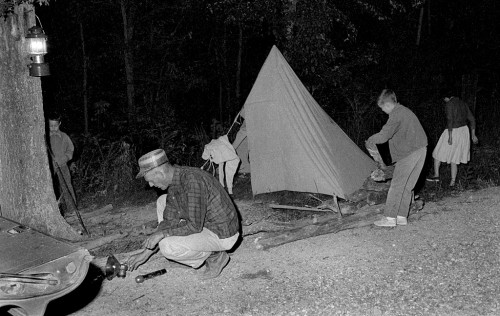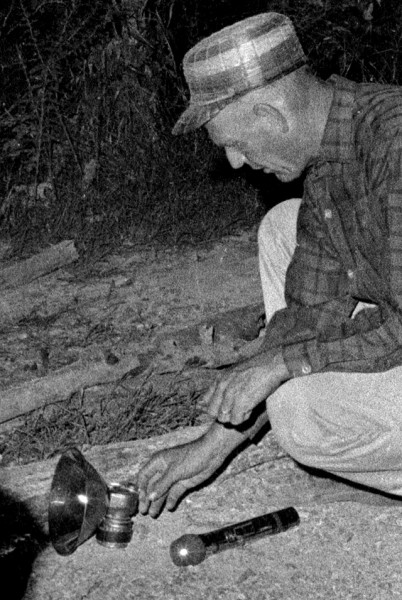 Here’s a shot of Dad helping set up a campsite. That’s Brother Mark hiding behind the tree. I’m pretty sure that’s Mother in the background looking for some poison ivy to step in. The setting is kind of odd: it’s right on a road and butts up to a fence. I don’t know who the boy on the right is. Brother David is in another shot, and that’s not him.
Here’s a shot of Dad helping set up a campsite. That’s Brother Mark hiding behind the tree. I’m pretty sure that’s Mother in the background looking for some poison ivy to step in. The setting is kind of odd: it’s right on a road and butts up to a fence. I don’t know who the boy on the right is. Brother David is in another shot, and that’s not him.
What caught my eye, though, was the lantern Dad is reaching for. It’s one of at least two carbide lanterns we owned. (Click on the photos to make them larger.)
What’s a carbide lantern?
 They were one of the most common sources of light for miners and coonhunters. There’s a good explanation of carbide lanterns on Mother Earth News.
They were one of the most common sources of light for miners and coonhunters. There’s a good explanation of carbide lanterns on Mother Earth News.
I’m pretty sure we bought the lanterns at Beard’s Sport Shop. They were simple devices. They consisted of a super-bright reflector attached to a device that contained two chambers. You put water in the top chamber and calcium carbide in the lower chamber. When you dripped water onto the carbide, it would emit acetylene gas – the same stuff you use mixed with oxygen for welding. A wheel flint, like on a cigarette lighter, would provide a spark to ignite the gas. No matches required.
Calcium carbide was available in just about any hardware store when I was a kid. We kept ours in a big glass jug with a wide mouth. It looked like gravel. In fact, we’d freak out new campers by putting some on the ground and pouring a little water on it. Casually pitching a match in the general direction of the brew, we’d warn them that you had to be careful where you built your fire because the gravel around there would burn. POOF! They’d spend an inordinate amount of time trying to light rocks until you clued them in.
The highly efficient reflectors would throw a beam a long way. If you cut back on the water drip, they’d burn for hours. The only catch was that they emitted a lot of soot that would clog the gas passage. They were great when they worked, but I always found them a pain to keep burning.
Carbide lanterns are hard to find these days. There was only one listing for carbide lanterns on Amazon. This caver site has some good information on how to buy a used lantern.

Neat little invention. I’d heard of carbide lanterns, but didn’t have a clue about them. I like learning how they did things “back in the old days.”
Ever hear of a candle-lantern? I took a tour of a cavern in South Dakota a few years ago and they gave us tin cans with candles in them. Hold the can sideways with one end cut out, light the candle, and the back of the can acts as a reflector. So we all lit our lanterns and they turned off the electric lights. I was amazed at how much light those little suckers put out in that cavern. The early cave explorers supposedly used them way back when.
Ken, Thanks for covering one of my on-going interests! I did a lot of cave exploring and carbide lamps then were the primary source of light (most Cavers have moved on to LEDs now). I collect carbide lamps and don’t really know how many I own. Some were designed to used on bicycles, some on cars, some worn on caps on your head. Our new hometown of Herndon, Virgina has a massive concrete bunker in the town square where a huge mixing chamber produced acetylene gas to light all the street lights in town. The bunker was to protect against an explosion (you didn’t mention that use of carbide….). I’m always looking for new carbide lamps that I don’t have – let me know if you come across one.
I’m pretty sure our lanterns weren’t anything exotic. I could probably find them if I poked around in the closet on the carport or up in the attic. The basic units were the same size, but one reflector was huge – I’m going to guess at least six inches and maybe as much as eight. The other was maybe four to six inches.
Yes, carbide could produce large amounts of gas and it it was very explosive if near a flame. I recall hearing rumors or legends about someone dumping carbide down a toilet at Central with supposedly interesting results. It happened before I got there, so I neither witnessed nor participated in the experiment.
I have a Justrite Carbide Lamp , model No. 2-840 with a 4 inch reflector,
never used. Purchased about 1968. Also a Justrite Carbide Hand Lamp , used slightly. Yours free for the museum.
i have a justrite carbide head lamp im wanting to find out imformation about its value
Your best bet is going to be eBay or the equivalent. I doubt that there are many carbide collectors on this site.
Good luck.
Carbide lights were used by my Father, uncles, grandfather and greatgrand father underground in the lead mines of the Lead Belt. We also used them for hunting and fishing and around the house. Battery flash lights were practically usless because of the short battery life. The lights provided to the miners had small reflectors so you could hold your hand over the reflector and allow the gas to collect under your palm before quickly sliding your hand past the flint to ignite the light. I never saw a commercial carbide light with a large reflector pictured in the article. However we would go the junk yard and get
a Model T headlight reflector and adapt it to our lights bacause they were brass and would penetrate water. The standard silver reflector would reflect back off the water
in your face making it difficult to gig fish.
If you took a small mayonaise type glass jar and put a few grains of carbide in the bottom, quickly dip up a little water, quickly screw on the lid and throw it high in the air it would most definately explode. Dangerous-of course
but that was what we did when I was a kid.
Years later I saw the same carbide lights used on the Marine Corps Rifle and pistol ranges to blacken rifle and pistol sights.
I have! We used them in the Spelunkers club at SEMO to explore caves. Alas, I didn’t last long as a spelunker because I discovered I was claustophobic! Not good for a cave enthusiast. But I still love reading about them.
Yep, played with carbide lanterns a lot when I was a kid. The hardware store on Good Hope had all of the replacement parts for them; reflectors, gas jets, gaskets, reservoirs and generation tanks. If they were kept clean, they would last nearly forever. I lost track of the two that I had. They were at my parents’ house before I moved away, but gone when my dad sold the house and its contents.
Dad was an avid coonhunter and we used the lanterns. A raccoon will more readily look at a soft lantern light that a bright flashlight and you can then see their eyes reflect the light at night while looking for them in trees. I took some carbide to school in my pocket and the humidity slowly made the unprotected granuals emit enough gas to make me sick and I had to throw them out. Dealing with the lanterns taught you a little about chemistry and fire safety.
Jerry says they used carbide lights on the tow boats he worked on. That’s what the bright white lights were that they used to spotlight at night.
So sorry. Jerry now says he was mistaken. The lights they used were carbon arc lamps. He says he had an old fart brain fart.
That makes more sense. Carbon arc lights are what they used in movie projectors, too.
Still have my original spider mount Justrite carbide lamp, plus two blade mounts that fit the older caving helmet…..my newer helmet is a Petzl Vertex with alike branded LED with mounting strap…..BUT, there were carbide lights at Spring MVOR in Perry County a couple of weeks back……mine still work!!! Tell Dennis Drum, I found two older Premier lamps at an antique mall over in Lawrence, Kansas last Friday, way cheap and I will return next week to grab ’em. There are those vintage cavers among us who still know how to use a carbide light, but only on shorter trips, and the LED’s and back-ups for the Crevice Cave, Berome Moore, and Mystery trips!!!! Be Well, Y’all, Cave Softly. kkr
We used to take a can that sealed tight, poke a hole in the bottom of it with an ice pick , then put some calcium carbide and water in it. Then lay it down and put our foot on it, wait a few seconds and put a match to the hole. It would blow the top off the can and make a really big boom also looked impressive at night.
When I was a kid in southern Indiana carbide lanterns were used as light in the coal mines. Every miner wore one. They put out good light but more soot than anything else, however, they worked and were used everywhere. We also would carry the solid carbide on to our school bus and if you put just a little water on the rock, it smelled like rotten eggs. That was the boys’ mischief. Wow, those carbide lantern days are long gone.
Tim Luckett